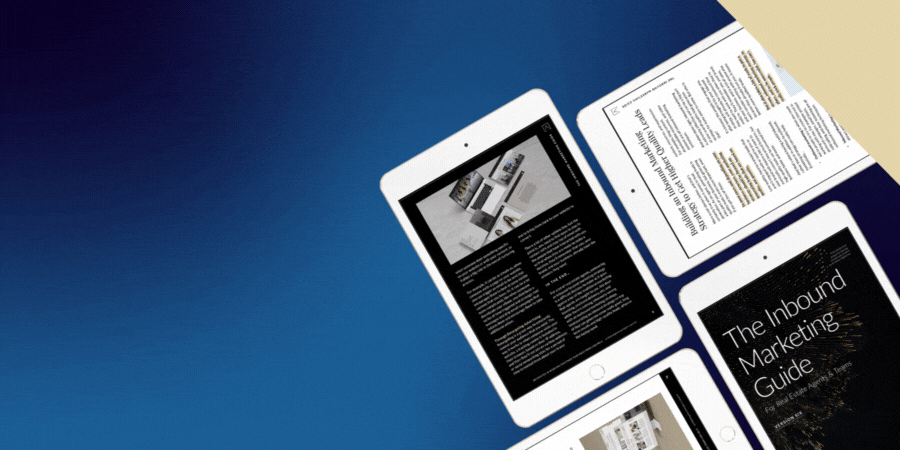There’s nothing worse than getting poor results (or no results at all) from a marketing strategy that you’ve put a lot of time, planning, and effort into.
A strong marketing strategy is all about reaching the right people, at the right time, for the right reasons, and if your target audience can’t discover you, or if the wrong people discover you, it’s easy to get discouraged and be left wondering what went wrong.
And if that’s the case, then that’s where building a marketing discoverability strategy comes in.
Your marketing discoverability strategy is how your target audience first discovers you; it’s how you get your marketing to reach the people that you want to work with, for the first time.
Before you build a marketing discoverability strategy, you should first look at how discoverable you are right now so you know where to concentrate your efforts.
For example, there are a lot of agents that purely rely on repeat and referral business, and while that may be perfectly fine at times, it also means that your marketing discoverability is limited; so when the market changes and your repeat and referral business isn’t transacting, you’ll be stuck.
On the other hand, if you have a strong discoverability strategy in place, it broadens your marketing reach and makes it easier for you to get new business by creating opportunities for new clients to discover you and your brand in multiple different ways.
There are 2 main components to building a marketing discoverability strategy:
- Your Organic Strategy: How your brand and business are found through natural channels.
- Your Paid Strategy: How your brand and business are found through paid channels.
In most cases, a strong marketing discoverability strategy will have both organic and paid components (although a stronger marketing discoverability strategy will place heavier emphasis on the organic component).
Through Your Organic Strategy
Your organic strategy is how people find you naturally, whether that’s in Google search results, another search engine, or even in social media.
The advantages of having a strong organic strategy in place are that they’re highly effective and won’t cost you any money (if you don’t outsource the work).
Having the right people find you at the right time organically is best achieved through your content strategy, by producing high-quality, well-written content that’s relevant to what your audience is looking for.
The disadvantages of an organic strategy are that it takes a lot of time, patience, and effort to see success. But it’s worth the effort and long-term investment.
When it comes to building a long-term, solid, marketing discoverability strategy that gets qualified results, organic is one of the best components to focus on because your organic strategy helps you build trust with your audience (over and above than you’ll ever achieve with a paid strategy), which is really important and effective if they’re first discovering you, because you can help them solve a problem.
For example, when someone is looking for an answer to something, one of the first places they’re likely to turn is a search engine, and if they find your website as a result of that search, and you solve a problem for them, they’ll begin to trust you.
Once your content is ready, your content marketing strategy kicks in, and if you’ve done everything correctly, you’ll have a solid organic strategy in place, that builds trust with your audience and runs in the background 24 hours a day.
★ Want to learn more about building an organic SEO strategy? Have a look at these posts:
- Optimizing Your Content for Humans (And Not Just for Search Engines)
- Writing Content for SEO as a Real Estate Agent
- Why You Should Establish a Topic Cluster Strategy
- Building a Well-Rounded SEO Search Strategy for Your Real Estate Website
Through Your Paid Strategy
Your paid strategy is how people find you through paid search result ads, promoted social media content, retargeting advertising, or even printed marketing materials if you’ve paid to have them distributed.
The advantages of a paid strategy are that you can ensure the right people see your advertising, at the right time, by specifically targeting them (although, that’s getting more difficult for agents because of advertising rules singling them out).
The disadvantages of a paid strategy are that obviously, it costs money to do, and if you stop spending money your paid strategy stops immediately. Plus, generally speaking, paid search often attracts less qualified leads (depending on what type of strategy and campaign you have in place).
For example, a very common paid search strategy will be to target searches based on someone searching for homes for sale in a particular area, but in those cases, you often attract people who are less committed and are really just looking for a home, not for a real estate agent.
In this case, they may still transact of course, but it will be a lot harder to get them there because of their lower level of commitment (and becasue you haven’t built any trust with them).
To be successful in paid search, you’re better off creating campaigns that focus on helping people solve problems and address their immediate needs, not just looking for homes for sale, because you’ll see more success in getting higher-quality leads (if that’s your goal).
But despite the cost and the complexities around creating a solid paid search, it can be worth the investment, based on your business model and team structure.
For example, because paid search (in the common advertising scenario above) generally attracts less-qualified, softer leads, a paid strategy can work better if you have a team that has newer buyers agents or ISAs because it’s often their job to convert lower-quality leads. Or, if you have a really solid lead nurturing strategy in place, you can also see a lot of success converting less-qualified buyers over time.
No matter how you approach it, a successful paid search strategy should be set up based on your audience, your team, your goals, and the systems you have in place.
★ Want to learn a bit more about building a paid advertising strategy? Have a look at these posts:
- Building a Well-Rounded Search Strategy Using Both Organic and Paid Sources
- Why Your Digital Advertising Strategy Might Not Get You Real Estate Leads
- The Anatomy of a Successful Real Estate Retargeting Campaign
Organic and Paid, Working Together
The advantages of having both organic marketing and paid marketing strategies in place are that you cover more bases; you can cast a wider marketing net by creating more opportunities for the people you want to work with to first discover you, while pushing away the people you don’t.
Want to get better, more qualified leads and build your authority? Our Inbound Marketing Guide is a walkthrough of the overall philosophy of inbound marketing, why it’s effective, and how you can build it into your own real estate marketing strategy to get better marketing results.




